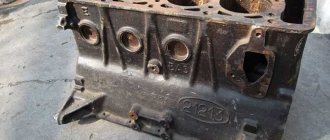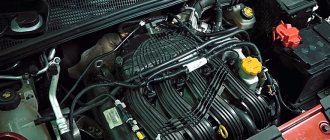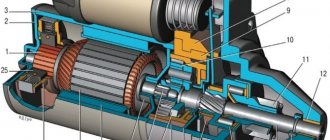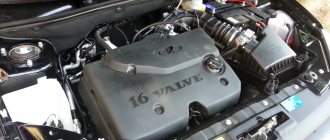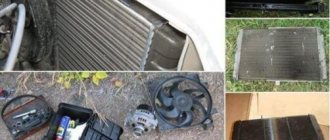The VAZ 21127 engine emerged in 2013 from the 21126 engine, completely retaining its design. Changes have been made to the design of the intake manifold - in the unit combined with the receiver, which was already used in the previous version, the developers installed dampers to regulate air flows.
ICE 21127
This, in turn, required the abandonment of the DMVR sensor; instead, DTV and DBP (air temperature and absolute pressure, respectively) are used. In other words, the designers have produced budget tuning, which is usually used by owners to independently increase engine power.
Design changes
The 21127 engine was created from the previous modification 21126 of the 2112 engine, so the main design remained the same:
- cylinder head – used from the first version 21124;
- gas distribution mechanism – DOHC scheme, two camshafts, phased injection;
- cylinder block – high type from 11183, cylinder surfaces are honed;
- connecting rod and piston group - lightweight, foreign made;
- Timing drive – belt, tooth profile rounded;
- exhaust tract - catalytic collector with a large landing size of the neutralizer;
- crankshaft - with a “long” crank radius, from 11183;
- flywheel – has a chamfer for a large diameter damper;
- ignition system – there is a separate coil for each spark plug, there are no high-voltage wires;
- fuel system – ramp with imported injectors (Siemens, Bosch);
- electronic motor control system – controllers M7.9.7 or January 7.2;
- attachments - a pump with a metal impeller has a long service life.
Receiver 21127
Fuel rail 21127
“As a legacy”, the 21127 engine received ultra-low oil consumption - only 0.1% of the amount of oil used by the system. However, for the operation of the valve and hydraulic lifter cooling system, the AvtoVAZ manufacturer’s operating manual recommends purchasing exclusively high-quality lubricant, which costs 10% more.
Basic list of faults
As the domestic manufacturer assures, the resource of the power unit is 200 thousand kilometers while maintaining operational properties. Nevertheless, even such a perfect design of the 21127 engine does not exclude the occurrence of various malfunctions. Friction can often be observed, however, this is typical for most modern power units. This mainly indicates clogged injectors. Washing them gives the desired result.
Problems with electronics can also occur. Often the people who suffer the most are:
- ignition coil;
- starter;
- electronic control unit;
- fuel pressure or idle speed regulator.
Sometimes you can hear knocking noises from the engine compartment. You should not put off inspecting your car indefinitely; it is better to immediately determine the source of the extraneous noise. It is likely that the sounds are made by hydraulic compensators, and then there is nothing to worry about.
You should panic if the cause of the knocking is not in these parts. With a greater degree of probability, this may indicate wear of the connecting rod and piston group.
Pros and cons of the motor
The main feature of the ICE 21127 remains the insufficient safety of the valves, which can be bent by the pistons if the timing belt breaks. The second disadvantage is the expensive overhaul, even if you do it yourself:
- the timing belt complete with automatic tensioner and pulley is expensive, as it is produced by the foreign company Gates;
- The ShPG kit also has a high price, since it is manufactured by another foreign manufacturer, Federal Mogul.
Damper control valve
The advantages of the design are:
- attachments are conveniently located, which reduces labor costs for maintenance and repairs;
- increased torque and power of the internal combustion engine.
On the one hand, the manufacturer AvtoVAZ has expanded its line of engines with version 21127. On the other hand, it has provided a new spare part - an improved receiver with an inertial charging system, which is a definite plus:
- owners of Grant, Prior and Kalin of the second generation, equipped with 21126 engines, can buy this unit;
- install it yourself instead of the standard receiver of the previous configuration;
- remove the mass air flow sensor, install DBP and DTV sensors to get a power of 106 hp. With. instead of the factory 98 hp. With.
There are no other changes in the design of the internal combustion engine; there is no need to re-register the car with the traffic police. Transport tax and insurance will be cheaper, since the plant’s vehicle certificate indicates less power.
Price of new and contract engine 21127
A new engine block 21127 from the AvtoVAZ assembly line will cost 55 - 70,000 rubles. The price includes:
- cylinder block with head;
- crankshaft;
- connecting rod and piston group;
- oil seals.
To complete the unit with a gas distribution mechanism, crankshaft pulley, flywheel, sump and oil receiver, you will have to pay from 75 to 105,000 rubles.
Engine 21127 with attachments is sold for 118 - 280,000 rubles. The price depends on the type of configuration. The maximum set includes:
- generator with bracket;
- ramp with nozzles;
- inlet receiver;
- an exhaust manifold;
- electronic throttle;
- catalyst;
- spark plug;
- pulleys;
- hoses, etc.
The price can also be influenced by the quality of spare parts: imported spare parts are more expensive than domestic ones, as are tuned ones relative to standard ones.
Contract engine 21127 can be purchased for 30 - 75,000 rubles. depending on configuration and mileage.
Which cars are equipped with ICE 21127?
Immediately after development, engine 21127 is recommended to be installed on cars manufactured by AvtoVAZ:
- Lada Granta - since 2013, Lux and Norma configurations;
- Lada Kalina-2 - since 2013, only with a manual transmission, mainly on sedans and hatchbacks;
- Lada Priora - since 2013, Luxury equipment.
Lada Priora Luxe configuration
In principle, the engine’s sufficiently high performance characteristics made it possible to install it on the Lada Largus, Vesta and X-Ray. However, by the time of their serial production, the ICE 21127 had been upgraded to the next version 21129 with a control unit that complies with Euro-5 standards, so the plant management limited itself to the indicated modifications, leaving the volumes the same.
Motor 21129
Technical characteristics of the VAZ 21127 engine
The Togliatti 127 engine produced in 2013 is a traditional 4-cylinder 16-valve engine with an injector. The cylinders operate according to the scheme 1 - 3 - 4 - 2, counting from the drive. Each cylinder has 2 intake and exhaust valves. Fuel injection is controlled by the M7.9 or January 7.2 electronic system.
The power of the unit is 78 kW or 106 horsepower. Engine 21127 reaches its maximum torque of 148 Nm at 4200 rpm. Without load, the motor runs at 800 - 850 rpm.
The 21127 engine is filled with synthetic and semi-synthetic oil with a viscosity of 5W-30 and 10W-40. Replacement will require 3 liters. It is important to observe the replacement period after 7500 - 8000 km, since the engine is equipped with hydraulic compensators that do not tolerate dirty lubricant. Oil consumption in a working unit does not exceed 0.1 l/1000 km.
According to toxicity standards 127, the engine meets Euro-4 requirements. AI-95 gasoline is suitable as fuel.
A mechanical gearbox or robot is installed in tandem with the 21127 engine. The power unit is mounted in the engine compartment on 4 supports. Brackets for mounting the supports are located on the front and rear walls of the cylinder block, as well as on the gearbox housing.
| Engine Specifications 21127 | Meaning |
| Cylinder diameter/piston stroke, mm | 82/75,6 |
| Ratio of cylinder volume to combustion chamber volume | 10,45 |
| Volume, l | 1,596 |
| Power, hp at 5800 rpm | 106 |
| Torque, Nm at 4200 rpm | 148 |
| Acceleration time to 100 km/h, s | 10,5 — 12,0 |
| Fuel consumption, l/100 km in the city | 10 |
| on the road | 6 |
| mixed | 7 |
| Fuel tank volume, l | 50 |
| Engine life, thousand km | 200 |
| Weight, kg | 116 |
Similar article Which engine is suitable for the VAZ 2106
Maintenance
In order to carry out major overhauls as rarely as possible, it is recommended to service engine 21127 according to the regulations:
- The timing belt drives the timing pulleys for 20–50 thousand km, but it needs to be inspected three times more often;
- The oxygen sensor has a slightly shorter service life - 10 thousand hours;
- The cooling system and the antifreeze itself, filters and fuel tank cap can withstand 40 thousand km of operation;
- the threshold of 25 thousand mileage cannot be overcome by spark plugs, belts and attachment belts;
- The filter along with the oil is changed every 10 thousand km.
To save budget, the internal combustion engine device allows you to perform all the specified maintenance operations in the garage without visiting service stations.
Typical breakdowns, causes, elimination
Since the 21127 motor uses a lightweight ShPG, as a result of a sudden belt break, the piston is 100% guaranteed to bend the valve. In addition, there are “diseases” characteristic of this motor:
| Power reduction | 1) burnt out valves 2) clogged air filter 3)fuel system malfunction 4) clutch slipping 5) wear of camshaft cams | 1)replacement of valves 2) cleaning or replacing consumables 3) cleaning and repair 4) clutch replacement 5) installation of a new camshaft |
| The internal combustion engine runs after the ignition is turned off | 1) carbon deposits inside the combustion chambers and on the valves 2) Problems with the ignition switch | 1)washing with a cleaning agent 2)replacing the ignition switch |
| Emergency pressure lamp comes on | 1) wear of the oil pump or main bearings 2) short circuit 3)low oil level | 1) replacement of parts 2) electrical repair 3) adding lubricant to the level |
In principle, no special complaints were noticed with the ICE 21127; this power drive is considered reliable and economical to operate.
Engine tuning
Initially, engine 21127 had already received factory tuning, but there were still opportunities to further increase power:
- In addition to the standard receiver, a damper with a diameter of 54 mm is mounted to achieve a performance of about 110 liters. With.;
- another 10 l. With. will be added by replacing the exhaust catifold with a “spider”;
- The Stolnikov camshaft modification 8.9 will provide power in the upper speed range.
Tuning 21127
Complex tuning is possible by installing a Stolnikov 9.15 camshaft with a phase shift of 316 degrees, replacing injectors with Bosch 431 360 (more efficient compared to standard ones) and milling the valve seat stages. In this case, the internal combustion engine will receive about 150 hp. With.
Thus, motor 21127 is an industrially tuned version of the previous internal combustion engine 21126. The characteristics are improved only by modifying the intake air system (damper inside the receiver plus DBP, DTV).
If you have any questions, leave them in the comments below the article. We or our visitors will be happy to answer them
Features of 21129 engine/differences
The main feature of the 129 engine is the “innovative” for AvtoVAZ installation of an intake receiver with variable chamber geometry and volume. Due to the damper, the volume of the intake chamber changes depending on the speed. As practice shows, the damper is activated at 3500 engine speeds.
In addition, the engineers managed to get rid of the mass air flow sensor - mass air flow sensor. Along with him, his ailments went away, which tormented the owner of the 21126 engine: unstable idling, sometimes exorbitant consumption, high cost. Instead of mass air flow sensors, engineers installed a connection from DBP and DTV sensors (atmospheric pressure and air temperature sensors). This is where the differences from the 126 engine end. Speaking in fact, the intake system with variable geometry is as old as the world and has been installed by global manufacturers almost since the 80s.
Differences 21129 from 21126 (mounted layout, transition from mass air flow sensor to DBP+DTV, presence of an intake receiver with variable geometry.
Differences between 21129 and 21127 (Different layout, different firmware)
